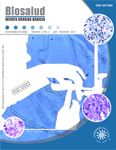Authors
Abstract
Objective: To compare the direct method and the precipitation method for the measurement of HDL cholesterol in canines. Materials and Methods: Blood samples of 156 fasting dogs were obtained from which 30 from different ages were randomly chosen without discrimination by sex or age. After serum extraction, levels of HDL cholesterol were determined by the direct method and and by the precipitation method. The results were statistically analyzed using one way ANOVA. Results: The values obtained by the direct method in mg/dl for media, minimal and maximal range, and standard deviation were 144,435; 33,532; 77,676; 197,594 respectively. Using the precipitation method, the values for media, minimal and maximal range, and standard deviation were: 133,337; 36,727; 81,457; and 242,724 respectively. The P value for the F test was greater or equal to 0.05 (0.627) without significant statistical difference between the two analyzed methods with a confidence level of 95% between the values obtained in both methods. Conclusion: Since there is not a significant difference, either of the analyzed methods for determining HDL cholesterol in this species can be used.
Keywords
References
Maldonado EN, Romero JR, Ochoa B, Aveldaño MI. Lipid and Fatty Acid Composition of Canine Lipoproteins. Comp Biochem Physiol B Biochem Mol Biol 2001; 128(4):719-729.
Montgomery R. Bioquímica: casos y texto. 6a Ed. Madrid, España: Harcourt Brace; 1998.
Pasquini A, Luchetti E, Cardini G. Plasma lipoprotein concentration in the dog: the effects of gender, age, breed and diet. J Anim Physiol Anim Nutr 2008; 2(6):718-722.
Xenouli PG, Steiner JM. Lipid metabolism and hyperlipidemia in dogs. Vet J 2010; 183(1):12-14.
Díaz C, Plaza E, Chimoy P. Niveles séricos de triglicéridos y colesterol en caballos peruanos de paso bajo dos sistemas de crianza. Rev investig vet Perú 2008; 19(2):134-138.
Attie AD. Lipoprotein/Cholesterol Metabolism. En: Meyers RA. Encyclopedia of Physical Science and Technology. 3a Ed. Ed. Madison, Wisconsin, U.S.A: Academic Press; 2004. p. 643-660.
King MW. Lipoproteins. The Medical Biochemistry Page Org. 2011 [Internet]. Disponible en: http://themedicalbiochemistrypage.org/lipoproteins.html. Consultado Julio de 2011.
Osorio JH. Total cholesterol and HDL-cholesterol in aging dogs. Biosalud 2006; 5:19-24.
Puppione DL, Bassilian S, Souda P, Macdonald MH, Hagland F, et al. Mass spectral analysis of the apolipoproteins on dog (Canis lupus familiaris) high density lipoproteins. Detection of apolipoprotein A-II. Comp Biochem Physiol Part D Genomics Proteomics 2008; 3(4):290-296.
Breininger E, Pintos L. Transporte de lípidos y patologías asociadas al metabolismo lipídico. Laboratorio de Lípidos y Proteínas. Área Química Biológica de la Facultad de Ciencias Veterinarias de la Universidad de Buenos Aires (UBA) 2007 [Internet]. Disponible en: http://www.portaldog.com.ar/textos/Metabolismo_de_lipido_en_caninos.htm. Consultado Mayo de 2013.
Xenoulis PG, Suchodolski JA, Levinski MD, Steiner JM. Investigation of Hypertriglyceridemia in Healthy Miniature Schnauzers. J Vet Intern Med 2007; 21(6):1224-1230.
Bailhache E, Briand F, Nguyen P. Metabolism of cholesterol ester of apolipoprotein B10- containing lipoproteins in dog: evidence for disregarding colesterol ester transfer. Eur J Clin Invest 2004; 34:527-534.
Maldonado EN, Casanave EB, Aveldaño MI. Major plasma lipids and fatty acids in four HDL mammals. Comp Biochem Physiol A Mol Integr Physiol 2002; 132(2):297-303.
Rigotti A, Krieger M. Getting a handle on “good” cholesterol with the high-density lipoprotein receptor. N Engl J Med 1999; 341(26):2011-2013.
Laboratorio veterinario de referencia (VET LAB SL). Lipidograma. 2012 [Internet]. Disponible en: http://www.vetlabsl.com/pdfs/LIPIDO1.PDF. Consultado Marzo de 2012.
Martínez-Gonzáles J. La apoproteína humana A-II determina los niveles de triglicéridos plasmáticos a través de la regulación de la actividad lipoproteína lipasa y del proteoma de las HDL. Clin Investig Arterioscler 2010; 22(4):176-177.
Warnick GR, Nauck M, Rifai N. Evolution of methods for measurement of HDL-cholesterol: from ultracentrifugation to homogeneous assays. Clin Chem 2001; 47:1579-1596.
Grove TH. Effect of reagent pH on determination of high-density lipoprotein cholesterol by precipitation with sodium phosphotungstate-magnesium. Clin Chem 1979; 25:560-564.
Julve J, Escolá-Gil JC, Rotllan N, Fiévet C, Vallez E, De la Torre C. Human apolipoprotein A-II determines plasma triglycerides by regulating lipoprotein lipase activity and high-density lipoprotein proteome. Arterioscler Thromb Vasc Biol 2010; 30:232-270.
Jeusette IC, Lhoest ET, Istasse LP. Influence of obesity on plasma lipid and lipoprotein concentrations in dogs. Am J Vet Res V 2005; 66(1):81-87.
García GD, Martín R, Navarro M, Cabrera A, Quintana L, et al. Evaluación de un método directo para la cuantificación de colesterol de LDL. Química clínica 2006; 25(2): 58-63.
Gómez-Gerique JA, Martin-Ballesteros B, García R, Esteban M, Fabiani F, et al. Evaluación multicéntrica de distintos métodos para la determinación de colesterol HDL directo con respecto al colesterol HDL de precipitación. Revista del laboratorio clínico 2012; 5(1):18-27.
Kimberly MM, Leary ET, Col TG, Waymack PP. Selection, Validation, Standardization, and Performance of a Designated Comparison Method for HDL-Cholesterol for Use in the Cholesterol Reference Method Laboratory Network. Clin Chem 1999; 45(10):1803-1812.
Dong J, Guo H, Yang R, LI H, Wang S, et al. Serum LDL- and HDL - cholesterol determined by ultracentrifugation and HPLC. J Lipid Res 2011; 52(2):383-388.

 PDF (Español)
PDF (Español)
 FLIP
FLIP














